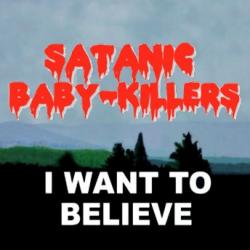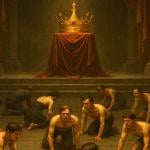I apologize for the click-bait-y formulation in the title of this post. It’s always presumptuous, and likely inaccurate, when online headlines insist that “You’ve Never Heard Of” someone or something. It’s quite possible that many of “you” reading this have, in fact, heard of Thomas of Monmouth.
But most people haven’t. Most people — most Christians — have never heard the story of Thomas of Monmouth. And that’s a problem, because most people — most Christians — have heard the story by Thomas of Monmouth. They’ve heard multiple versions of its endless variations.
It’s a story that has been told and retold for centuries. This story has shaped our faith and the culture of Western Christendom. It directly influenced later, better-known works by Chaucer and Luther and, even today, we can see its influence in both works of popular entertainment and scholarly theology. Every generation has adopted and adapted this story, repackaging it and repurposing it for each succeeding day and age. In my own time and place, I don’t think it’s possible to understand American Christianity or American politics in the 21st Century without understanding this story — the story invented and promoted by Thomas of Monmouth way back in the 12th Century.
And the most important thing to understand about Thomas of Monmouth’s massively, enduringly influential and culture-shaping story is this: It’s a lie. It’s a vicious, outrageous fabrication — the product of an evil, deceitful man with a twisted mind.
To understand Thomas’ story, you must first understand the story that preceded his arrival on the scene. That story, unlike the one later told by Thomas, is something that really happened.
What happened was this: During Holy Week in 1144, a 12-year-old boy named William left home to take a job working in the kitchen of the Archdeacon of Norwich, England. His body was found a few days later in the woods outside the town. The boy had apparently been beaten to death.
The local sheriff, a man named John de Chesney, was unable to identify William’s killer. The only thing he was sure of was that no evidence suggested the local Jewish community had anything to do with the boy’s death. So when the good Christian people of Norwich formed a lynch-mob to round up their Jewish neighbors, de Chesney sheltered them in Norwich Castle until the furor died down.

And that was that. Or it should have been. The sad end of a sad story from a time and place in which life was often nasty, brutish, and short.
But then several years later, in 1150, an ambitious monk named Thomas of Monmouth rolled into town.
Thomas had big plans to put his new home on the map. That was going to be a challenge, since Norwich didn’t have the sort of lucrative holy shrines or holy relics Thomas needed for his scheme. What the town needed, he decided, was a local saint. And so Thomas set out to invent one: the martyred “Saint” William of Norwich.
Thomas began concocting fantastical tales of “miracles” he attributed to the saintly intervention of the young boy, supported by “evidence” supplied to him in sacred visions he said he received from the now-long-dead original bishop of Norwich. Those stories helped him to sell his makeshift cult of “Saint” William, but the scheme didn’t really take off until he let his lurid imagination run wild in the darkest fantasies he could spin.
Thomas cranked out a hagiography titled The Life and Miracles of Saint William of Norwich — a book he would continually expand and embellish for the next several decades. Despite its title, Thomas’ tale had relatively little to say about either William’s life or the miracles posthumously attributed to him. It was mainly about William’s death — a death Thomas attributed to the secret ritual human sacrifice carried out by the nefarious Other he refers to throughout the book as “our enemies”: the Jews.
Thomas describes William’s ritual murder in gleeful, gruesome detail, suggesting that the boy was actually crucified in an elaborate Satanic mockery of Jesus’ crucifixion. He attributes all of this new detail — all of which contradicts every account from the time of William’s death — to a variety of unidentifiable “witnesses” and otherwise unattested “deathbed confessions.” The real story had not been previously told, he suggested, because all of these supposed witnesses feared retribution from the global conspiracy of Satan-worshipping, child-killing Jews.
In short, Thomas of Monmouth invented the blood libel.
And it was a runaway smash hit. Christians loved this story and couldn’t get enough of it, embellishing it with ever-more depraved detail as it spread throughout Europe. Other cities rushed to venerate their own local child-martyr “saints” supposedly slain in the Satanic rituals of the Jews.
Chaucer included a variation of Thomas’ story in The Canterbury Tales. More than 500 years later, in 1994, Dale W. Griffis told a variation of Thomas’ story to an Arkansas jury, helping to wrongly convict the West Memphis Three. “Pizzagate” and the “QAnon” conspiracy theory roaring through Tea Party Republicanism are nothing but modern remixes of the story told by Thomas of Monmouth.
And here is President Donald J. Trump, offering his own garbled rendition of Thomas’ ancient tale just this weekend at a campaign rally in Wisconsin:
"The baby is born, the mother meets w/the doctor. They take care of the baby. They wrap the baby beautifully. Then the doctor and mother determine whether or not they will execute the baby."
How is this man's mental state not a National Emergency right now? pic.twitter.com/uq2yPoxH3o
— Amee Vanderpool (@girlsreallyrule) April 28, 2019
Some would say that the Satanic Panic and QAnon and other modern variations of Thomas of Monmouth’s tale are different from the original blood libel because they initially do not identify “the Jews” as the orchestrators of their alleged Satanic conspiracies. But that’s only briefly true, and only on the surface. Follow the threads of any of these manias long enough and you’ll find they all wind back to the same anti-Semitic fantasies introduced in the source material.
Trump’s wild claims of rabid evil Democrats hankering for infanticide might seem, at first, to be directed only at his political opponents and their supporters rather than at “the Jews.” But ask him or his audience why his claims aren’t being reported on and condemned in “the media,” or why they think “coastal elites” and “intellectuals” and “Hollywood” are so depraved and debased as not to share their ginned-up outrage over the imaginary martyrdom of countless innocent infants and you’ll get an answer no different from the one you’d have heard from Thomas and all the other good Christians in Norwich back in 1150.
Consider the parallel arguments from two Orthodox Presbyterian terrorists. Paul Jennings Hill claimed he was taking up arms against a global conspiracy of Satanic baby-killers just like the one described by Thomas of Monmouth. And so Paul Hill killed two people at a Florida abortion clinic. Last week, a young man from the same white Southern-gothic Presbyterian denomination claimed he was taking up arms against a global conspiracy of Satanic baby-killers and so he killed one woman and injured three other people attacking a synagogue in Poway, California.
It’s Thomas of Monmouth’s world. We’re all just living in it.











